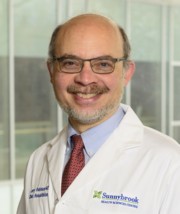St. John's Rehab Program
SRI programs

Senior scientist
St. John’s Rehab
285 Cummer Avenue, Room S125
Toronto, ON
M2M 2G1
Clinical Profile
Phone: 416-480-4475
Fax: 416-480-4674
Clinical Summary:
Dr. Robinson is a physiatrist with a special focus on electromyography. His clinical activities are focused on diagnosis of focal neuropathies and radiculopathies as well as other neuromuscular conditions.
Research Profile
Administrative Assistant: Nancy Riley
Phone: 416-226-6780, ext. 7274
Email: nancy.riley@sunnybrook.ca
- BA, 1978, chemistry, Brandeis University, U.S.
- MD, 1982, medicine, Baylor College of Medicine, U.S.
- Physical medicine and rehabilitation residency, 1985, Northwestern University, U.S.
- Fellow, American Board of Physical Medicine and Rehabilitation (FABPMR), 1987
- Board certification in neuromuscular medicine, 2011
Appointments and Affiliations:
- Senior scientist, Evaluative Clinical Sciences, St. John’s Rehab Research Program (director), Sunnybrook Research Institute
- Program chief, rehabilitation services, Sunnybrook Health Sciences Centre
- Head, division of physical medicine and rehabilitation, Sunnybrook
- Professor and division director, physical medicine and rehabilitation, department of medicine, University of Toronto
- John and Sally Eaton Chair in Rehabilitation Science
Research Foci:
- Prognosis of awakening after coma
- Impact of physical medicine and rehabilitation consults in acute care
- Electrodiagnosis in traumatic and focal neuropathies
Research Summary:
Dr. Robinson’s research is focused on three areas.
His work on prognosis for awakening after hypoxic ischemic encephalopathy is directed at allowing critical care teams to recommend discontinuing life support more confidently when chances of awakening are less than 1%. He aims to improve eletrophysiologic methods for prognostication and use statistical methods to develop models that predict outcomes with more certainty.
His work on exploring the impact of acute care physical medicine and rehabilitation (PM&R) consult is supported by a grant from the Innovation Fund, which is sponsored by Ontario government and the Ontario Medical Association. In this work, he and his research team are exploring the impact of having a PM&R consultant see trauma and burn patients during their acute care stay.
In the areas of focal and traumatic neuropathies Dr. Robinson’s interest has been on optimizing analysis of multiple data points and predicting outcomes better. His publications on the diagnosis of carpal tunnel syndrome have improved the reliability of testing and reduced the incidence of false positive results related to performing multiple independent tests. This method reduces multiple observations into a single summary variable (usually called the Robinson index). In traumatic neuropathy, improved ability to prognosticate outcome in patients with traumatic peripheral nerve injuries means that therapeutic interventions can be tailored to individual patients.
Selected Publications:
See current publications list at PubMed.
- Robinson L, Chapman M, Schwartz M, Bethune A, Potapova E, Strauss R, Scales D. Patterns of use of somatosensory evoked potentials for comatose patients in Canada. J Crit Care. 2016 Dec;36:130–33.
- Tam AKH, Berbrayer D, Robinson LR. What should be the role of physiatrists in early acute care rehabilitation? Current literature, models of care, and thoughts for the future. Am J Phys Med Rehabil. 2016 Mar;95(3):225–9.
- Robinson LR. How electrodiagnosis predicts clinical outcomes of focal peripheral nerve lesions. Muscle Nerve. 2015 Sep;52(3):321–33.
- Robinson LR, Micklesen PJ, Tirschwell DL, Lew HL. Predictive value of somatosensory evoked potentials for awakening from coma. Crit Care Med. 2003 Mar;31(3):960–7.
- Robinson, LR. Traumatic injury to peripheral nerves. Muscle Nerve. 2000 Jun;23(6):863–73.
Related News and Stories:
- Early physical medicine and rehabilitation consults benefit critically injured patients: study: Seeing a physiatrist during acute care is associated with shorter hospital stays (June 18, 2019)
- Undaunted: journey through trauma: one man's story of survival and healing (SRI Magazine, 2017)
- Esteemed recognition: Physiatrist receives lifetime achievement (April 19, 2017)


